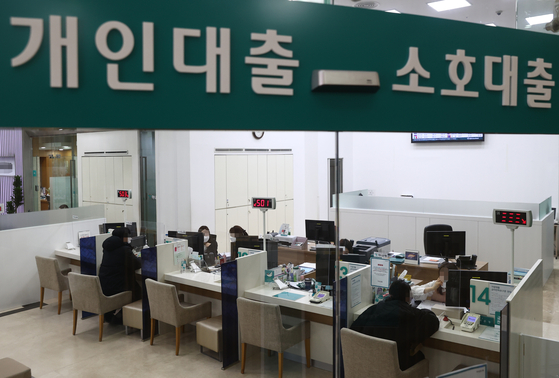Confusion continues after the Financial Services Commission announced on the 19th that it would introduce a system of’mandatory installment payment of large credit loans’ through its work plan. This is because no specific criteria for repayment in installments or the timing of implementation have been established. Concerns are growing from the perspective of consumers who have to make a funding plan. We have summarized four issues related to credit loan installment repayment, which has recently gained interest.
[신용대출 분활상환 4가지 이슈]

On the 5th, customers who visit a bank loan in Seoul are receiving counseling. yunhap news
① Why are only credit loans tightened?
In the aftermath of last year’s rise in jeonse prices and debt investment (investment from debt), credit loans and jeonse loans raised household debt. According to major commercial banks (KB Kookmin, Shinhan, Hana, Woori, and NH Nonghyup), last year’s credit loans increased 21.6% (23,7374 billion won), and cheonsei loans increased 30.6% (24,645.6 billion won). It is 80% of the total household loan increase (59,3977 billion won). Financial authorities believe that household debt growth is also fast, so additional regulations are needed.
Regarding this, in the financial sector, there is an opinion that the surge in credit loans will be caught only after partly easing the regulations on the head of charge, as there is a balloon effect of the head charge regulation against the background of the surge in credit loans. However, it is a difficult problem for the financial authorities to decide due to the flow of real estate policies devoted to’catching house prices’. An official from the banking sector said, “The loan problem is complicated, but due to problems such as debt, the financial authorities seem to have been engrossed in catching credit loans.”

Household loans boosted by credit and whole household loans. Graphic = Reporter Jaemin Shin [email protected]
② The standard for large credit loans is 100 million won? More than an annual salary?
The high standard for which principal repayment is mandatory is also controversial. The Financial Services Commission mentioned’more than a certain amount’ in the work plan, but did not provide specific standards. On the 19th, Chairman Eun also said on the timing of the introduction on the 19th that it was “idea level” and “after saying that it would be good to do this in a large framework as a work plan, we will do it this year.” In the credit loan management plan, if the total amount of credit loans received by high-income earners with an annual income of more than KRW 80 million exceeds KRW 100 million, the total debt repayment ratio (DSR) regulation per borrower is applied.
However, the financial authorities are in the position that “nothing has been decided” for specific amounts such as 100 million won. The financial authorities are reviewing a variety of measures, such as setting a separate standard based on annual salary, rather than standardizing the amount standard. In the financial sector, a plan to repay only a certain portion of credit loans that exceeds income is also discussed. For example, if an employee with an annual salary of 80 million won receives a credit loan of 100 million won, it is a plan to repay only 20 million won in installments. An official from the Financial Services Commission said, “We are currently considering what standards to apply mandatory repayment,” and “We are considering various things, such as taking time to step down the standard amount after setting the initial application standard high in consideration of market impact.” said.

Finance Commissioner Eun Seong-soo is explaining the work plan of the Financial Services Commission for 2021 at the joint briefing room of the Seoul Government Complex in Jongno-gu, Seoul on the 18th. Financial Committee
③ Not applicable to existing credit loans
Amortization is not retroactively applied to existing credit loans. The same applies to annual renewal of a loan that has already been received. The financial authorities and the financial sector explained that the annual credit loan renewal is not a renewal, but a procedure to recalculate interest rates by checking credit information such as annual income. In general, the maturity of lump-sum credit loans is 10 years and the amortization credit loans maturity is 5 years. Temporary repayment of principal will not be applied until such maturity is reached and the contract is renewed.
The negative bankbook, which is a limited-term loan method, is also not applicable. The position of the financial authorities is that the concept of amortized repayment cannot be applied because it is a method used when necessary with a set limit.

Contents related to the mandatory amortization of credit loans announced by the Financial Services Commission in its work plan on the 19th. Financial Committee
④ Financial market that is popular in installment payments
Measures including the amortization plan will be included in the’Advanced Household Debt Management Plan’, which will be announced in March, but the application time has not been decided yet. The financial authorities explained that they will decide when to apply it after seeing the situation of COVID-19 prevention.
However, it is pointed out that even if it is not a large credit loan, it is necessary to prepare for when amortization is applied in the future. Whenever the government comes up with measures related to household debt such as comprehensive household debt management measures in 2015, the government is pushing for a transition to amortization. As of last year, the target for the proportion of commercial banks’ amortized payments is 57.5%. At the end of June 2015, the portion of amortization was around 33%. Financial authorities are also encouraging the launch of amortization products for out-of-generation loans.
Research Fellow Seo Byung-ho said in ‘2021 Banking Industry Outlook and Management Task’, “It is necessary to induce voluntary deleveraging of borrowers by increasing the proportion of amortization of household loans, focusing on credit loans.”
Reporter Ahn Hyo-seong [email protected]
